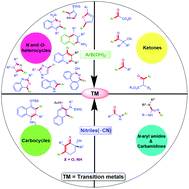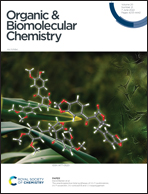Metal-catalyzed reactions of organic nitriles and boronic acids to access diverse functionality
Abstract
The nitrile or cyano (–CN) group is one of the most appreciated and effective functional groups in organic synthesis, having a polar unsaturated C–N triple bond. Despite sufficient stability and being intrinsically inert, the nitrile group can be easily transformed into many other functional groups, such as amines, carboxylic acids, ketones, etc. which makes it a vital group in organic synthesis. On the other hand, despite several boronic acids having a low level of genotoxicity, they have found wide applicability in the field of organic synthesis, especially in transition metal-catalyzed cross-coupling reactions. Recently, transition-metal-catalyzed cascade additions or addition/cyclization processes of boronic acids to the nitrile group open up exciting and useful strategies to prepare a variety of functional molecules through the formation of C−C, C−N and C![[double bond, length as m-dash]](https://www.rsc.org/images/entities/char_e001.gif) O bonds. Boronic acids can be added to the cyano functionality through catalytic carbometallation or through a radical cascade process to provide newer pathways for the rapid construction of various important acyclic ketones or amides, carbamidines, carbocycles and N,O-heterocycles. The present review focuses on various transition-metal-catalyzed additions of boronic acids via carbometallation or radical cascade processes using the cyano group as an acceptor.
O bonds. Boronic acids can be added to the cyano functionality through catalytic carbometallation or through a radical cascade process to provide newer pathways for the rapid construction of various important acyclic ketones or amides, carbamidines, carbocycles and N,O-heterocycles. The present review focuses on various transition-metal-catalyzed additions of boronic acids via carbometallation or radical cascade processes using the cyano group as an acceptor.



 Please wait while we load your content...
Please wait while we load your content...